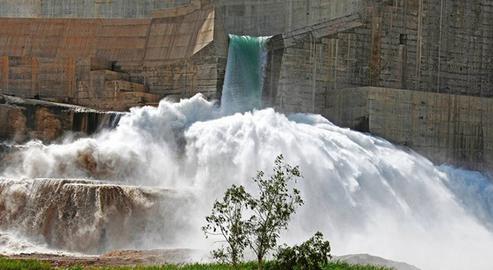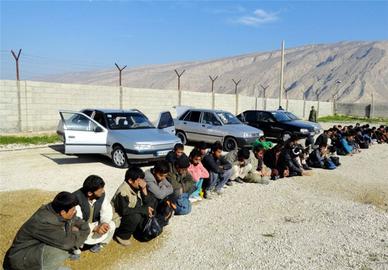It is always a surprise to hear a high official in the Islamic Republic publicly confess to a major blunder. But that is exactly what Isa Kalantari, head of Iran’s Environmental Protection Agency, did on July 10. At a meeting with students from Amir Kabir University [Persian link], he announced: “You could have expected any part of Iran to be hit by drought, but Khuzestan was the last place you would have expected it.” Kalantari was referring to the disastrous drought in the southwestern province that has led to widespread protests in its major cities. “The problem in Khuzestan is mismanagement of water and a failure to recognize priorities.”
He referred to Gotvand Dam as one of the major mistakes in this regard. “With this one engineering mistake, we turned Khuzestan’s water salty,” he told the students. This was not the first time that Kalantari had talked about the dam, albeit with less poignancy. Studies about Gotvand Dam lacked “necessary depth,” he said in 2015 and revealed that around 19 percent of the basin behind the dam was filled with salt.
Gotvand Dam, completed in 2012, is one of the biggest dams in Iran. It is built over the Karun River, the country’s only navigable river, stretches 950 kilometers, and empties into the Shatt al-Arab waterway. It is Iran’s biggest embankment dam and its reservoir has a capacity of 4.5 billion cubic meters, making it the second biggest artificial lake in the country.
Experts have been criticizing Gotvand Dam for years. Hamid Reza Khoda-Bakhshi, president of Khuzestan’s Association of Water Engineers, is one of them. He told the newspaper Hamshahri: “According to studies by Tehran University, Gotvand Dam has increased the salt in the Karun River by 35 percent.”
They Knew — But They Built it Anyway
“Another disastrous development for the wetlands has been the dams constructed in recent decades, which have left the waterbeds dry and helped exacerbate water and earth salinity,” reported the Guardian in 2015. “Gotvand Dam, opened three years ago to supply the sugarcane plants, lies on salt beds.” An engineer who had worked on the dam told the Guardian: “We had done the research for the area around Gotvand dam in the 1970s, that’s why the dam wasn’t built then, we knew it would directly affect the salt concentration of the water. The numbers, the research, was all there, but they built it anyway.”
In 2016, environmental officials said that the dam had contributed to the death of 400,000 palm trees in one area of Khuzestan in 2014, due to the exponential increase in the salinity of the Karun River, which has made the already harsh environment unbearable for palm trees. The damage has severe implications on Iran’s agriculture and economy because 40 percent of Iran’s exported dates are produced in Khuzestan.
The Domino Effect
“The water crisis is a very complex issue,” a water expert told IranWire. “It is like a clock with a set of big and small gears. If even one of these gears does not work the rest of them will stop working as well. This is what happened with the water crisis in Khuzestan. On the one hand, they have made the water salty through sugarcane agriculture and building dams like Gotvand. On the other hand, some farmers cultivate rice, which needs a lot of water. They redirect water on one hand and on the other hand, they hold water behind dams, increasing evaporation and wasting water.”
“When the volume of fresh water falls, salty water pushes in,” he said. “And when the quality of water drops, the environment is damaged. Now, both of these things have happened in Khuzestan: Both the quality of water and the volume of fresh water have gone down. The water is taken away upstream and the cultivation of sugarcane, the Gotvand Dam, and the discharge of sewage have both reduced the quality of water and made it saline.”
In November 2015, Mohammad Ali Banihashemi, an engineer in fluid mechanics with the University of Tehran and the head of the Steering Committee to Desalinate Gotvand Dam, called the dam a “national mistake” [Persian link] and said that, according to studies carried out by Tehran University, Gotvand Dam is responsible for 25 percent of the pollution in Karun River. According to him, the university had recommended two solutions. The first was to release the water in the dam’s reservoir into salt evaporation ponds through 35-km pipelines. The second was to manage the reservoir directly using specialist engineering techniques.
The first suggestion was considered to be too costly, and officials declared that the second solution would be put into action. But, according to Mohsen Sedghi, a professor with Azad University and the director of its Water Engineering and Science Faculty, this approach has failed. “The claim that the saltiness of Gotvand water has gone down is not true,” he told IranWire. “Like a brine factory, Gotvand Dam’s reservoir is still making the water of Karun salty and destroying the land in Khuzestan.”
For years now Sedghi has championed the diversion of Karun’s water away from the dam and its reservoir. “Considering the major role that Gotvand plays in salinizing Karun’s water, the only solution is to transfer the water through a canal to the city of Shushtar so it will not come into contact with salt. Yes, it is costly but it is better than allowing all the land in Khuzestan to turn into a salt desert.”
Denials and Finger Pointing
Disagreement over the environmental crisis and how to cope with it have been rife, and officials have been unable to arrive at a solution or even apportion blame. Over the last few years the dam issue has gained increasing attention — but the media and the experts have also been unable to agree on who to blame. The prime suspects, however, are the Ministry of Energy and the big engineering contractor Khatam-al Anbiya Construction Headquarters, an affiliate of the Revolutionary Guards.
Not only does the Ministry of Energy not accept responsibility, it routinely denies that the salt content of Karun River has increased. And the Revolutionary Guards point the finger at the ministry. “The Guards were only the contractors for the Gotvand project,” said General Ebadollah Abdollahi, commander of Khatam-al Anbiya Construction Headquarters. “If in the Gotvand Dam we have hit a salt dome, the responsibility lies with the consultant’s design.” The project consultant was Mahab Ghodss Consulting Engineering Co, which works under the supervision of the Ministry of Energy.
Unkept Promises
Besides fights in the media, in 2015 the Supreme Audit Court of Iran confirmed errors in the construction of the Gotvand Dam. Amin Hossein Rahimi, president of the court, announced that it would prosecute those who went ahead with building the dam despite the discovery of salt domes. And yet, as of now, nobody has been brought to court.
“We made mistakes that must definitely be attended to,” Reza Ardakanian, the current Minister of Energy — and deputy minister of energy when the dam was built — said during his confirmation hearings at the parliament. “Not only to learn a lesson — naturally this is necessary to avoid future mistakes — but also for taking legal action against any negligence or culpability in this regard. And I am specifically referring to Gotvand Dam. This issue will be pursued by consulting qualified experts trusted by the country.”
But this promise has not been kept either.
The scandal over Gotvand has become so complex that even the suggestion of putting the dam out of operation has become a full-fledged crisis in itself. In late 2017, Isa Kalantari of the environmental agency told the newspaper Shahrvand: “If we destroy Gotvand Dam, Khuzestan will be flooded. Taking Gotvand Dam off the grid requires a budget of 10 trillion tomans [over $2.3 billion] and would take 12 years.”
The Shahrvand newspaper report was entitled “An Incurable Disease”— a perfect description.
More on water shortage and unrest in Khuzestan:
“We Are Thirsty, Not Saboteurs”, July 2, 2018
Forced to Migrate for a Glass of Drinking Water, June 29, 2018
Police Open Fire on Thirsty Crowds, July 1, 2018
More on drought and environmental crisis in Iran:
An Iranian Patriot Vs. a Corrupt System, April 19, 2018
Drought in Sistan and Baluchistan, December 14, 2017
New Health Warnings for Lake Urmia, July 20, 2015
Disaster is Looming, June 15, 2015
New Fears For Public Health near Lake Urmia, May 28, 2015
“Iran Could end up like the Horn of Africa”, January 30, 2015
Crime: Defending the Environment, November 4, 2014
Iran's Provincial Water Wars, November 7, 2013
visit the accountability section
In this section of Iran Wire, you can contact the officials and launch your campaign for various problems

























comments